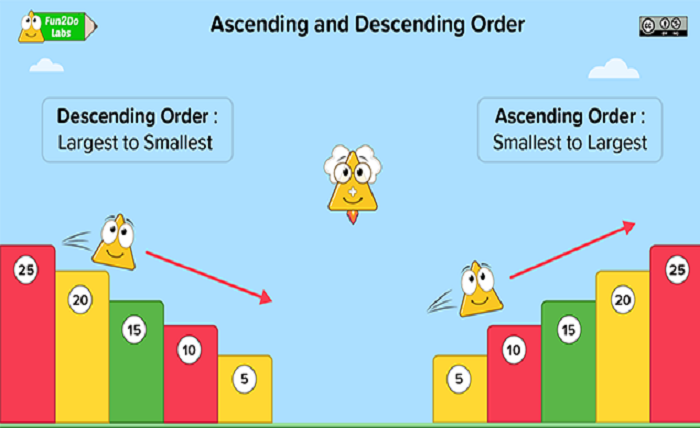Ascending Order and Descending Order: A Comprehensive Guide

Ascending order and descending order are fundamental concepts in data organization, used across various fields such as mathematics, computer science, and everyday life. Ascending order arranges items from the smallest to the largest, based on a particular property like number, date, or even alphabetical order. Conversely, descending order sorts items from the largest to the smallest. Understanding these orders is crucial for analyzing data effectively and is widely applied in sorting algorithms, databases, and when generating reports. This section introduces these concepts, setting the stage for a deeper exploration of their practical applications and importance.
The Basics of Ascending Order
Ascending order is a method used to arrange data points or elements so that they increase in magnitude. This order is particularly useful in scenarios where you need to display items from the least to the greatest, such as organizing names in an alphabetical list or sorting numerical data from smallest to largest. The application of ascending order makes data easier to search through and analyze, as it follows a natural progression that aligns with how humans typically process numerical and textual information. Understanding how to implement and utilize ascending order can significantly enhance data management and organization skills.
Descending Order
Descending order organizes data so that each element is greater than or equal to the ones that follow. This order is essential in cases where the highest values are of primary interest, such as displaying the top scores in a competition or listing the most significant recent transactions in a financial report. Descending order provides a clear overview of the highest measures first, facilitating quick insights into the upper limits of the data set. Employing descending order effectively can help in prioritizing tasks, managing inventories, and analyzing financial statements, making it a versatile tool in data handling.
Implementing Ascending Order in Programming
In computer programming, implementing ascending order involves algorithms that sort data from lower to higher values. Popular sorting algorithms like Bubble Sort, Merge Sort, and Quick Sort can efficiently arrange data in ascending order. These algorithms differ in complexity and efficiency, making some more suitable for large datasets than others. Understanding these algorithms’ mechanics and when to apply them is crucial for developers and anyone involved in data processing or analytics. Programming languages such as Python, Java, and C++ offer built-in functions and libraries to help implement ascending order efficiently.
Descending Order in Database Queries
Descending order is frequently used in database operations, especially when retrieving records that need to be displayed from the most recent to the oldest or from the highest to the lowest. SQL, the standard language for managing relational databases, allows for easy implementation of descending order through the “ORDER BY” clause, specifying whether the sorting should be in ascending (ASC) or descending (DESC) order. Mastery of these queries enhances the ability to handle large datasets and retrieve information in the most useful format for decision-making and reporting.
Ascending and Descending Order in Everyday Life
Both ascending and descending orders have practical applications in everyday life, from organizing books on a shelf in alphabetical order to sorting emails by date. These concepts are integral to effective personal organization and are used in cooking recipes, filing systems, appointment scheduling, and more. Understanding how to apply these orders in daily tasks can simplify decision-making processes and increase efficiency in managing personal and professional responsibilities.
Ascending Order in Statistical Analysis
In statistical analysis, ascending order is crucial for methods such as calculating percentiles, quartiles, and other statistical measures. By arranging data in ascending order, statisticians can more easily identify the median, detect patterns, and apply statistical models. Ascending order facilitates a clearer understanding of the distribution of data, which is essential for hypothesis testing, forecasting, and interpreting large datasets. Effective use of this order enhances the accuracy and reliability of statistical conclusions.
The Impact of Descending Order on User Experience Design
In user experience (UX) design, descending order can significantly influence how information is presented to users. For example, news websites often display the most recent articles first, while e-commerce sites might show best-selling products at the top of the page. This method prioritizes important or time-sensitive information, ensuring users see the most relevant data first. UX designers must understand how to leverage descending order to enhance usability and meet user expectations effectively.
Educational Applications of Ascending and Descending Order
Ascending and descending orders are not just mathematical concepts but are also critical in educational settings. These sorting methods are taught early in mathematics education to help students understand numerical relationships and data organization. They also apply in organizing classroom materials, planning lessons, and grading in order to streamline educational processes and make learning environments more orderly and conducive to student success.
Advanced Techniques in Ascending and Descending Orders
In advanced applications, particularly in data science and advanced computing, ascending and descending orders are part of more complex operations such as machine learning algorithms, data mining, and big data analytics. These techniques involve sorting vast amounts of data to identify trends, make predictions, and drive decision-making processes. Professionals in these fields must be adept at using sophisticated tools and algorithms to manipulate and sort data effectively according to the required criteria.
Conclusion
Ascending and descending orders are more than just basic organizational tools; they are fundamental to the effective analysis and presentation of data across various disciplines. From enhancing user interfaces to facilitating complex statistical analysis, understanding how to correctly apply these sorting methods is crucial. This knowledge not only improves data handling efficiency but also aids in making informed decisions based on well-organized data.
FAQs:
1. What is ascending order?
Ascending order is a way of sorting data from the smallest to the largest based on specific criteria.
2. How is descending order different from ascending order?
Descending order sorts data from the largest to the smallest, which is the opposite of ascending order.
3. Why are ascending and descending orders important in databases?
These orders help in efficiently retrieving and organizing data, making databases more effective in managing information.
4. Can ascending order be used in qualitative data analysis?
Yes, ascending order can organize qualitative data like textual information alphabetically or based on other qualitative metrics.
5. What are some common algorithms used for sorting in ascending order?
Common algorithms include Bubble Sort, Merge Sort, and Quick Sort, each varying in efficiency and suitability for different data sizes.




